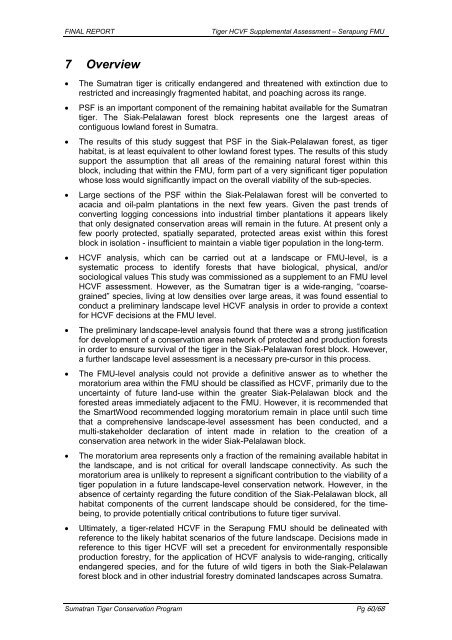A Supplemental HCVF Assessment on the Sumatran Tiger ...
A Supplemental HCVF Assessment on the Sumatran Tiger ...
A Supplemental HCVF Assessment on the Sumatran Tiger ...
Create successful ePaper yourself
Turn your PDF publications into a flip-book with our unique Google optimized e-Paper software.
FINAL REPORT <strong>Tiger</strong> <str<strong>on</strong>g>HCVF</str<strong>on</strong>g> <str<strong>on</strong>g>Supplemental</str<strong>on</strong>g> <str<strong>on</strong>g>Assessment</str<strong>on</strong>g> – Serapung FMU<br />
7 Overview<br />
• The <strong>Sumatran</strong> tiger is critically endangered and threatened with extincti<strong>on</strong> due to<br />
restricted and increasingly fragmented habitat, and poaching across its range.<br />
• PSF is an important comp<strong>on</strong>ent of <strong>the</strong> remaining habitat available for <strong>the</strong> <strong>Sumatran</strong><br />
tiger. The Siak-Pelalawan forest block represents <strong>on</strong>e <strong>the</strong> largest areas of<br />
c<strong>on</strong>tiguous lowland forest in Sumatra.<br />
• The results of this study suggest that PSF in <strong>the</strong> Siak-Pelalawan forest, as tiger<br />
habitat, is at least equivalent to o<strong>the</strong>r lowland forest types. The results of this study<br />
support <strong>the</strong> assumpti<strong>on</strong> that all areas of <strong>the</strong> remaining natural forest within this<br />
block, including that within <strong>the</strong> FMU, form part of a very significant tiger populati<strong>on</strong><br />
whose loss would significantly impact <strong>on</strong> <strong>the</strong> overall viability of <strong>the</strong> sub-species.<br />
• Large secti<strong>on</strong>s of <strong>the</strong> PSF within <strong>the</strong> Siak-Pelalawan forest will be c<strong>on</strong>verted to<br />
acacia and oil-palm plantati<strong>on</strong>s in <strong>the</strong> next few years. Given <strong>the</strong> past trends of<br />
c<strong>on</strong>verting logging c<strong>on</strong>cessi<strong>on</strong>s into industrial timber plantati<strong>on</strong>s it appears likely<br />
that <strong>on</strong>ly designated c<strong>on</strong>servati<strong>on</strong> areas will remain in <strong>the</strong> future. At present <strong>on</strong>ly a<br />
few poorly protected, spatially separated, protected areas exist within this forest<br />
block in isolati<strong>on</strong> - insufficient to maintain a viable tiger populati<strong>on</strong> in <strong>the</strong> l<strong>on</strong>g-term.<br />
• <str<strong>on</strong>g>HCVF</str<strong>on</strong>g> analysis, which can be carried out at a landscape or FMU-level, is a<br />
systematic process to identify forests that have biological, physical, and/or<br />
sociological values This study was commissi<strong>on</strong>ed as a supplement to an FMU level<br />
<str<strong>on</strong>g>HCVF</str<strong>on</strong>g> assessment. However, as <strong>the</strong> <strong>Sumatran</strong> tiger is a wide-ranging, “coarsegrained”<br />
species, living at low densities over large areas, it was found essential to<br />
c<strong>on</strong>duct a preliminary landscape level <str<strong>on</strong>g>HCVF</str<strong>on</strong>g> analysis in order to provide a c<strong>on</strong>text<br />
for <str<strong>on</strong>g>HCVF</str<strong>on</strong>g> decisi<strong>on</strong>s at <strong>the</strong> FMU level.<br />
• The preliminary landscape-level analysis found that <strong>the</strong>re was a str<strong>on</strong>g justificati<strong>on</strong><br />
for development of a c<strong>on</strong>servati<strong>on</strong> area network of protected and producti<strong>on</strong> forests<br />
in order to ensure survival of <strong>the</strong> tiger in <strong>the</strong> Siak-Pelalawan forest block. However,<br />
a fur<strong>the</strong>r landscape level assessment is a necessary pre-cursor in this process.<br />
• The FMU-level analysis could not provide a definitive answer as to whe<strong>the</strong>r <strong>the</strong><br />
moratorium area within <strong>the</strong> FMU should be classified as <str<strong>on</strong>g>HCVF</str<strong>on</strong>g>, primarily due to <strong>the</strong><br />
uncertainty of future land-use within <strong>the</strong> greater Siak-Pelalawan block and <strong>the</strong><br />
forested areas immediately adjacent to <strong>the</strong> FMU. However, it is recommended that<br />
<strong>the</strong> SmartWood recommended logging moratorium remain in place until such time<br />
that a comprehensive landscape-level assessment has been c<strong>on</strong>ducted, and a<br />
multi-stakeholder declarati<strong>on</strong> of intent made in relati<strong>on</strong> to <strong>the</strong> creati<strong>on</strong> of a<br />
c<strong>on</strong>servati<strong>on</strong> area network in <strong>the</strong> wider Siak-Pelalawan block.<br />
• The moratorium area represents <strong>on</strong>ly a fracti<strong>on</strong> of <strong>the</strong> remaining available habitat in<br />
<strong>the</strong> landscape, and is not critical for overall landscape c<strong>on</strong>nectivity. As such <strong>the</strong><br />
moratorium area is unlikely to represent a significant c<strong>on</strong>tributi<strong>on</strong> to <strong>the</strong> viability of a<br />
tiger populati<strong>on</strong> in a future landscape-level c<strong>on</strong>servati<strong>on</strong> network. However, in <strong>the</strong><br />
absence of certainty regarding <strong>the</strong> future c<strong>on</strong>diti<strong>on</strong> of <strong>the</strong> Siak-Pelalawan block, all<br />
habitat comp<strong>on</strong>ents of <strong>the</strong> current landscape should be c<strong>on</strong>sidered, for <strong>the</strong> timebeing,<br />
to provide potentially critical c<strong>on</strong>tributi<strong>on</strong>s to future tiger survival.<br />
• Ultimately, a tiger-related <str<strong>on</strong>g>HCVF</str<strong>on</strong>g> in <strong>the</strong> Serapung FMU should be delineated with<br />
reference to <strong>the</strong> likely habitat scenarios of <strong>the</strong> future landscape. Decisi<strong>on</strong>s made in<br />
reference to this tiger <str<strong>on</strong>g>HCVF</str<strong>on</strong>g> will set a precedent for envir<strong>on</strong>mentally resp<strong>on</strong>sible<br />
producti<strong>on</strong> forestry, for <strong>the</strong> applicati<strong>on</strong> of <str<strong>on</strong>g>HCVF</str<strong>on</strong>g> analysis to wide-ranging, critically<br />
endangered species, and for <strong>the</strong> future of wild tigers in both <strong>the</strong> Siak-Pelalawan<br />
forest block and in o<strong>the</strong>r industrial forestry dominated landscapes across Sumatra.<br />
<strong>Sumatran</strong> <strong>Tiger</strong> C<strong>on</strong>servati<strong>on</strong> Program Pg 60/68

















